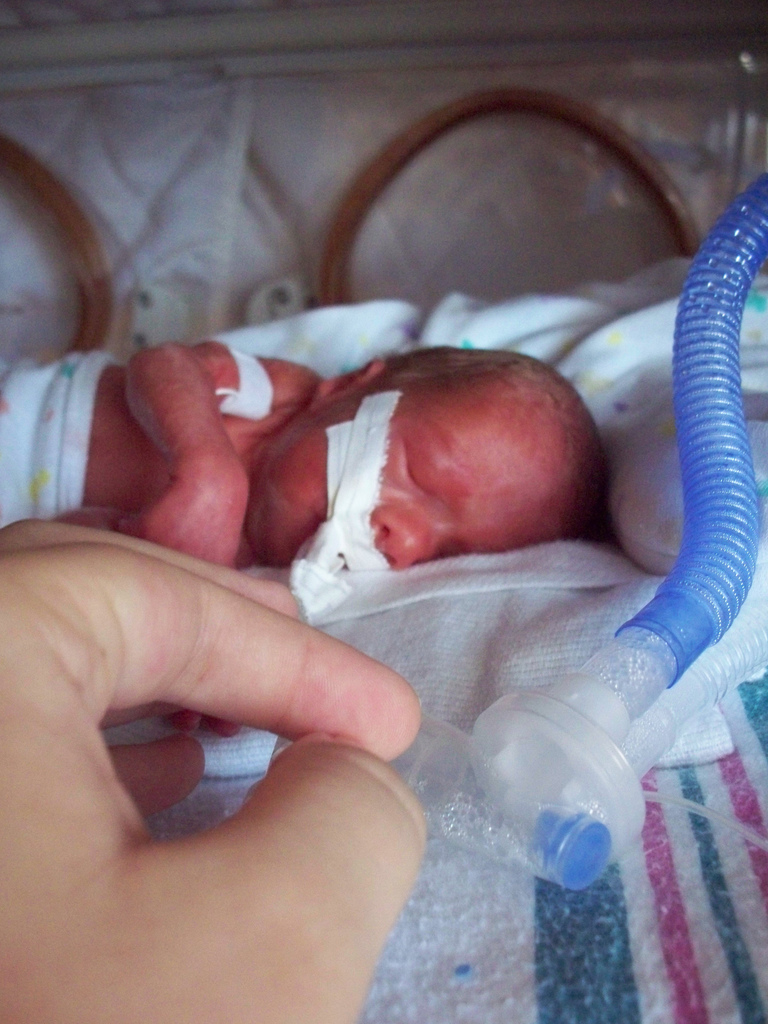
審定稿:https://en.wikipedia.org/wiki/Wikipedia:WikiProject_Medicine/Translation_task_force/RTT/Simple_preterm_birth
中文:https://zh.wikipedia.org/wiki/%E6%97%A9%E7%94%A2
<!-- 模板 -->

{{Infobox disease
| Name = Preterm birth
| ICD10 = {{ICD10|O|60|1|o|60}}, {{ICD10|P|07|3|p|05}}
| ICD9 = {{ICD9|644}}, {{ICD9|765}}
| ICDO =
| Image = Premature infant with ventilator.jpg
| Caption = [[Medical ventilator|Intubated]] preterm baby in an [[neonatal incubator|incubator]]
| OMIM =
| OMIM_mult =
| MedlinePlus = 001562
| eMedicineSubj = ped
| eMedicineTopic = 1889
| DiseasesDB = 10589
| MeshID = D047928
}}
Preterm birth, also known as premature birth, is the birth of a baby at less than 37 weeks gestational age.[1] These babies are known as preemies or premmies.[1] Symptoms of preterm labor include uterine contractions which occur more often than every ten minutes or the leaking of fluid from the vagina.[2] Premature infants are at greater risk for cerebral palsy, delays in development, hearing problems, and problems seeing. These risks are greater the earlier a baby is born.[1]
<!-- 定義與症狀 -->
’’’早產’’’({{lang-en|preterm birth, premature birth}}),指[[嬰兒]]在{{link-en|胎齡|Gestational age}}低於37週時[[分娩]]的狀況[1],其嬰兒被稱為’’’早產兒’’’({{lang|en|preemies, premmies}}[1])。早產的症狀包含每次{{link-en|子宮收縮|Uterine contraction}}間隔少於10分鐘,或液體從陰道流出[2]。早產兒會有[[腦麻痺]]、{{link-en|發展遲緩|Developmental disability}}、[[聾|聽力]]與[[視力障礙]]等巨大風險,越早出生則風險越大[1]。
The cause of preterm birth is often not known.[3] Risk factors include diabetes, high blood pressure, being pregnant with more than one baby, being either obese or underweight, a number of vaginal infections, tobacco smoking, and psychological stress, among others.[3][4] It is recommended that labor not be medically induced until after 39 weeks unless required for other medical reasons. The same recommendation applies to cesarean section.[3] Medical reasons for early delivery include preeclampsia.[5]
<!-- 病因 -->
早產的原因尚不明朗[3],其風險因子包含[[糖尿病]]、[[高血壓]]、懷有多於1個胎兒、[[肥胖症]]或[[體重不足]]、一系列[[陰道炎]]、[[吸菸]]與{{link-en|壓力 (心理學)|Stress (psychological)|心理壓力}}等等[3,4]。除非有其他醫療狀況如[[妊娠毒血症]][5],孕期直到39週以前不建議採取[[引產]]等提前分娩措施,對於[[剖腹產]]而言也適用這樣的建議[3]。
In those at risk the hormone progesterone if taken during pregnancy may prevent preterm birth. Bed rest is not useful.[6] It is estimated that at least 75% of preterm infants would survive with appropriate treatment.[3] In women who might delivery between 24 and 34 weeks corticosteroids improve outcomes.[7] A number of medications including nifedipine may delay delivery so that a mother can be moved to where more medical care is available and the corticosteroids have a greater chance to work.[8] Once the baby is born care includes keeping the baby warm through skin to skin contact, supporting breastfeeding, treating infections, and supporting breathing.[3]
<!-- 預防與治療 -->
對於高風險孕婦而言,在懷孕期間採用[[孕酮]]可預防早產,而臥床休息並無法避免早產[6]。估計至少75%早產兒可藉由適當治療而存活[3]。於24-34週之間分娩的婦女可藉由[[皮質類固醇]]提高預後成效[7]。一系列如{{link-en|硝苯地平|Nifedipine}}可以讓母親延遲分娩,期能後送至提供更多醫療照護的場域,且能使皮質類固醇發揮更大功效[8]。一旦嬰兒出生,必須進行一系列護理措施,包含藉由肌膚間接觸使嬰兒保暖、[[母乳餵養]]協助、[[感染]]治療與呼吸協助[3]。
Preterm birth is the most common causes of death among infants worldwide.[1] About 15 million babies are preterm each year (5% to 18% of all deliveries). In many countries rates of premature births have increased between the 1990s and 2010s.[3] Complications from preterm births resulted in 0.74 million deaths in 2013 down from 1.57 million in 1990.[9] The chance of survival at less than 23 weeks is close to zero, while at 23 weeks it is 15%, 24 weeks 55% and 25 weeks about 80%.[10] The chances of survival without long term difficulties is less.[11]
<!-- 流行病學與預後 -->
早產是全球各地嬰兒最常見死因[1]。每年有將近1,500萬的早產兒(大約是占所有生產的5-18%)。1990到2012年代,許多國家的嬰兒早產率都有上升趨勢[3]。早產相關併發症,相較於1990年造成157萬名嬰兒死亡,2013年降低到了74萬名[9]。23周以前出生的嬰兒,存活率幾乎為零;懷孕23周出生的早產兒存活率為15%,24周為55%,25周存活率則接近八成[10]。週數較大的早產兒,之後的相關併發症也較少[11]。